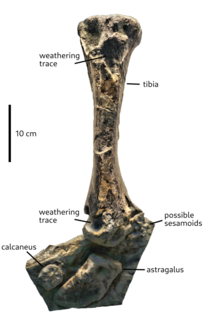| Ohmdenosaurus Temporal range: early Toarcian,
| |
|---|---|

| |
| The only known specimen (bones of the lower leg) in posterior (rear) view, on exhibit at the Urweltmuseum Hauff, Germany | |
| Scientific classification | |
| Domain: | Eukaryota |
| Kingdom: | Animalia |
| Phylum: | Chordata |
| Clade: | Dinosauria |
| Clade: | Saurischia |
| Clade: | †Sauropodomorpha |
| Clade: | †Sauropoda |
| Genus: | †Ohmdenosaurus Wild, 1978 |
| Species: | †O. liasicus
|
| Binomial name | |
| †Ohmdenosaurus liasicus Wild, 1978
| |
Ohmdenosaurus ('Ohmden lizard') is a genus of sauropod dinosaur that lived during the Early Jurassic epoch in what is now Germany. The only specimen – a tibia (shinbone) and ankle – was discovered in rocks of the Posidonia Shale near the village of Ohmden. The specimen, which was originally identified as a plesiosaur, is exhibited in a local museum, the Urweltmuseum Hauff. In the 1970s, it caught the attention of German palaeontologist Rupert Wild, who recognised it as the remains of a sauropod. Wild named Ohmdenosaurus in a 1978 publication; the only known species is Ohmdenosaurus liasicus.
One of the earliest known sauropods, Ohmdenosaurus was quadrupedal (four-legged) and already had the columnar limbs typical for the group. It was small for a sauropod, with an estimated length of 3–4 m (10–13 ft). Its relationships to other sauropods remain uncertain due to the incompleteness of its remains, though one study concluded it was a eusauropod. The Posidonia Shale was deposited within a shallow inland sea and contains abundant and well-preserved fossils of marine reptiles, including ichthyosaurs and plesiosaurs. Ohmdenosaurus was a terrestrial animal, and the specimen must have been transported by predators or water currents at least 100 km (60 mi) from the shoreline to its site of burial. It is the only dinosaur fossil known from the shale.